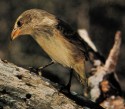Allopatry
The Galapagos Islands are close enough to one another that finches were able to migrate among them and establish populations on each. However, the geographical separation (allopatry) is great enough to limit interbreeding between populations on different islands. This situation has made possible the formation of distinctive subspecies (= races) on the various islands.
Sympatry
The Cocos Island is located some 500 miles to the northeast of the Galapagos and 340 miles from the Pacific coast of Costa Rica, a long distance from the nearest land. The area is 9.2 square miles. Nearly 90 bird species have been reported, but there are only seven species of land birds including one finch among them. The finches are sympatric in their distribution and have not differentiated into separate races.
Adaptation

|
Appearance
Darwin's finches differ somewhat in size and their feathers are gray, brown, black or olive. They have short rounded wings and a rounded tail that often appears cocked to one side. Most male finches mature to a solid black color, while the females mature to a drab grayish color. Vegetarian and tree finch males never become completely black, but have a black head, neck, and upper breast. Warbler, woodpecker and mangrove finches have more of an olive color.
Feeding
The finches vary by what they eat, some eating seeds and others insects. The ground finches eat ticks they remove with their crushing beaks from tortoises, land iguanas and marine iguanas kick eggs into rocks to feed upon their contents. On Isla Wolf the sharp-beaked ground finch is known as the "vampire finch" as it jumps on the backs of masked boobies and red-footed boobies pecking at their flesh and feeding on their blood. Woodpecker and mangrove finches use small twigs and cactus spines as tools to dine on the larvae stored in dead tree branches.
Seasonal Variation
Though they have adapted to allow for specialized feeding, most finches are generalized eaters. When food is scarce, their specializations make the birds successful competitors for food resources with other birds and animals, and they survive during the dry season or times of drought when little food is available.